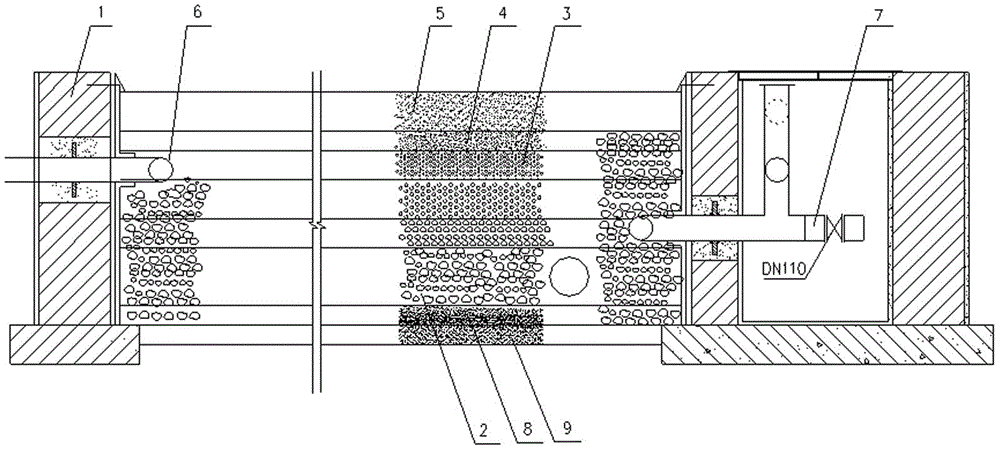A method for breeding and domesticating subsurface flow constructed wetland plants
A technology of subsurface wetlands and constructed wetlands, applied in chemical instruments and methods, sustainable biological treatment, biological water/sewage treatment, etc., can solve the problems of poor adsorption and enrichment capacity, low oxygen transport capacity, etc. The effect of strong ability, developed root system and dense stems and leaves
- Summary
- Abstract
- Description
- Claims
- Application Information
AI Technical Summary
Problems solved by technology
Method used
Image
Examples
Embodiment 1
[0024] The length of the subsurface wetland unit designed in this embodiment is 30m, the width is 20m, the hydraulic gradient of the subsurface wetland unit is 0.5%, and the adjustable water depth of the subsurface wetland unit is controlled at 0.3m. The designed organic load of the wetland unit is set at 60kgBOD / ha.d for BOD, and the designed hydraulic load is 0.3m / day.
[0025] The present embodiment selects any one of reed, cattail and wild rice stem to be planted alone, and the reed is taken as an example below to illustrate: the selection and domestication method of subsurface flow constructed wetland plants comprises the following steps:
[0026] Step 1: Select the above subsurface wetland unit, including the first subsurface wetland unit for the first acclimatization and the second subsurface wetland unit for the second acclimatization.
[0027] Step 2: Plant reed seedlings on the planting soil with a thickness of 150 mm in the first subsurface wetland unit, and the pla...
Embodiment 2
[0036] The subsurface wetland unit designed in this embodiment has a length and width of 30m and a width of 20m; the hydraulic gradient of the subsurface wetland unit is 1.0%, and the adjustable water depth of the subsurface wetland unit is controlled at 1.2m. The designed organic load of this wetland unit is 80kgBOD / ha.d, and the designed hydraulic load is 0.4m / day.
[0037] The present embodiment selects any one of reed, cattail and wild rice stem to be planted alone, and the cattail is taken as an example below to illustrate: the selection and domestication method of subsurface flow constructed wetland plants comprises the following steps:
[0038] Step 1: Select the above subsurface wetland unit, including the first subsurface wetland unit for the first acclimatization and the second subsurface wetland unit for the second acclimatization.
[0039] Step 2: Plant reed seedlings on the planting soil with a thickness of 300mm in the first subsurface flow wetland unit, and the ...
Embodiment 3
[0047] The subsurface wetland unit designed in this embodiment has a length and width of 30m and a width of 20m; the hydraulic gradient of the subsurface wetland unit is 0.8%, and the adjustable water depth of the subsurface wetland unit is controlled at 0.8m. The designed organic load of this wetland unit is 110kgBOD / ha.d, and the designed hydraulic load is 0.45m / day.
[0048] The present embodiment selects any one of reed, cattail and wild rice stem to be planted separately, and the wild rice stem is taken as an example below to illustrate: the breeding and domestication method of subsurface flow constructed wetland plants comprises the following steps:
[0049] Step 1: Select the above subsurface wetland unit, including the first subsurface wetland unit for the first acclimatization and the second subsurface wetland unit for the second acclimatization. The subsurface flow wetland unit in this embodiment includes:
[0050] Step 2: Plant reed seedlings on the planting soil w...
PUM
| Property | Measurement | Unit |
|---|---|---|
| thickness | aaaaa | aaaaa |
Abstract
Description
Claims
Application Information
 Login to View More
Login to View More - R&D
- Intellectual Property
- Life Sciences
- Materials
- Tech Scout
- Unparalleled Data Quality
- Higher Quality Content
- 60% Fewer Hallucinations
Browse by: Latest US Patents, China's latest patents, Technical Efficacy Thesaurus, Application Domain, Technology Topic, Popular Technical Reports.
© 2025 PatSnap. All rights reserved.Legal|Privacy policy|Modern Slavery Act Transparency Statement|Sitemap|About US| Contact US: help@patsnap.com

